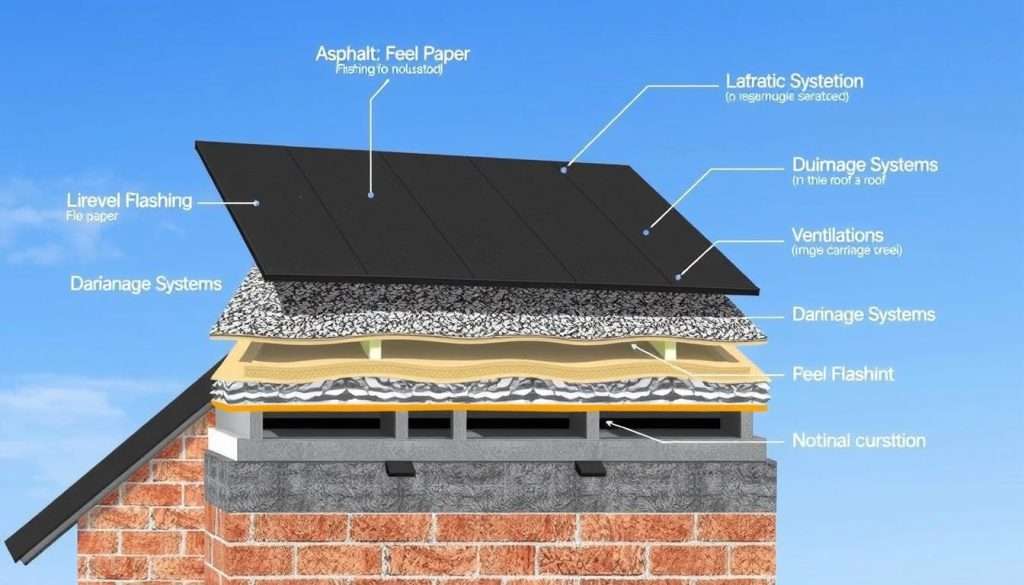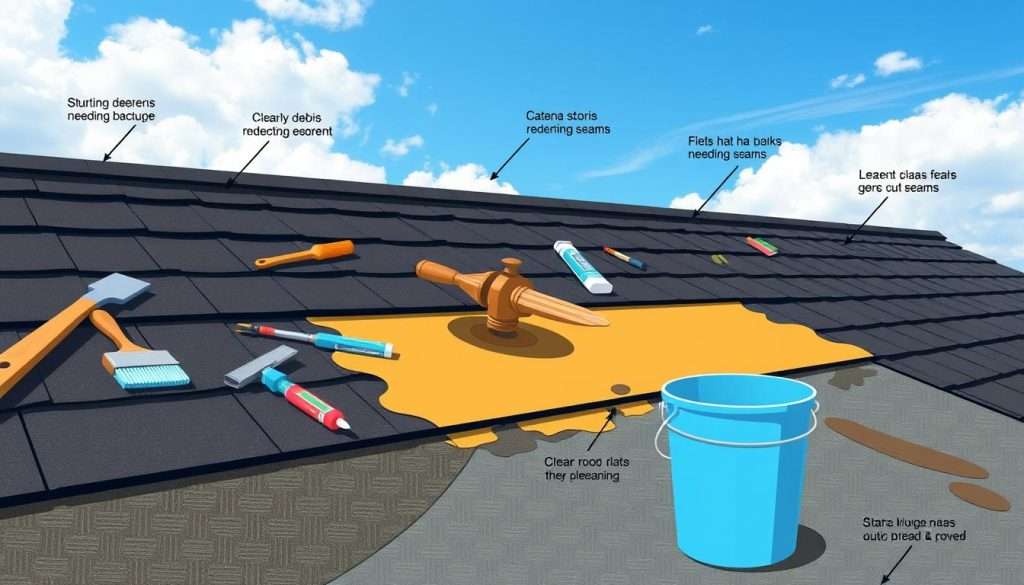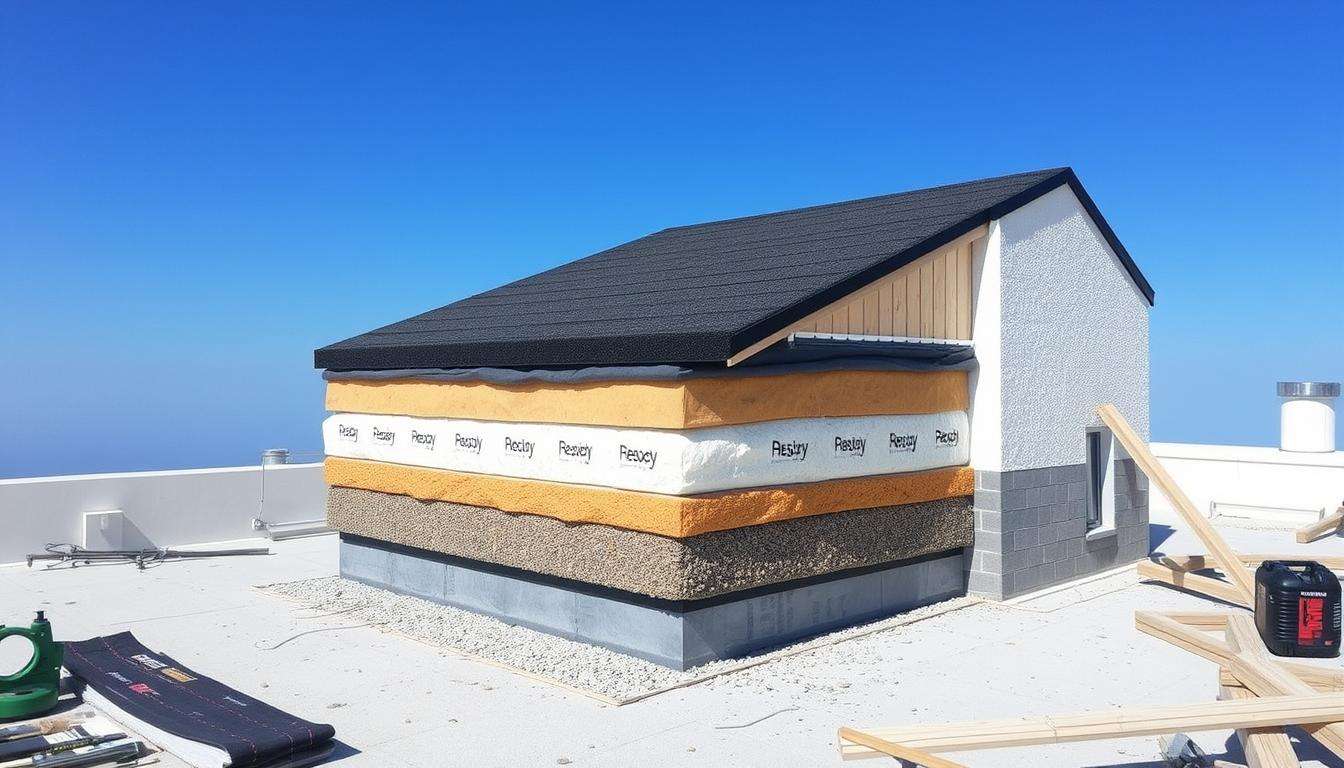Knowing about built-up roofs is key for homeowners and DIY fans. This roofing style has been around since the mid-1800s. It’s known for being strong and simple.
A built-up roof is made of many layers. These layers include asphalt and ply sheets. They work together to keep water out, especially on flat or low-slope roofs.
BUR systems are popular for their long-lasting and reliable performance. They have more layers than other types of roofs. This makes them stronger.
These roofs can handle different weather conditions well. They keep your roof safe from leaks and water damage. With the right care, a built-up roof can last 15 to over 30 years. It’s a smart choice for your home.
What is a Built-Up Roof?
A built-up roof (BUR) is a strong roofing system. It has many layers of materials like bitumen and fabrics. This makes it great for flat roofs because it keeps water out.
For over a hundred years, built up roofing has been a top choice. It’s known for being tough and reliable in many weather conditions.
Definition of Built-Up Roof
So, what is a built up roof? It’s a strong roofing solution with many layers. This design helps protect against bad weather.
The BUR roof has several layers that make a tight seal. This reduces leaks a lot. Modern BUR systems use better materials than old tar, making them even better.
How Built-Up Roofs Differ from Other Roofing Types
Built up roofs are special because they have many layers. This is different from single-ply membranes, which don’t offer the same protection.
BUR roofs also handle wind and rain better. They are less likely to be blown off. This makes them great for big buildings in cities.
| Feature | BUR Roof | Traditional Roofs |
|---|---|---|
| Layers | Multiple | Single |
| Lifespan | 20-30 years | 15-20 years |
| Water Resistance | Excellent | Moderate |
| Wind Resistance | Highly Resistant | Less Resistant |
| Installation Cost | Higher Initial | Lower Initial |
| Maintenance | Low | Varies |
Components of a Built-Up Roof
A built-up roof has many important parts. Each part helps the roof last longer, keep warm or cool, and protect buildings. Knowing these parts helps us see how they make a strong BUR roof.
Base Layers and Insulation
The base of a built-up roof is base layers and insulation. It starts with insulation, like polyisocyanurate, on a base. This layer keeps the roof warm or cool and supports it.
The base layer also helps keep water out. It adds to the roof’s insulation.
Waterproofing Membranes
Then, waterproofing membranes are added. They use asphalt or adhesives with felts. This makes the roof waterproof and strong.
The membranes keep the roof together. They protect it from water and weather, making it last longer.
Protective Top Surface
The last part is the protective top surface. It can be a cap sheet or gravel. This layer protects from weather and UV rays.
A good top surface keeps the roof safe. It also helps with drainage and saves energy. For example, a white cap sheet keeps the inside cool and saves money.

| Component | Function | Benefits |
|---|---|---|
| Base Layers and Insulation | Provide structural support and thermal resistance | Enhances energy efficiency and prevents leaks |
| Waterproofing Membranes | Create a moisture barrier | Long-lasting protection against water intrusion |
| Protective Top Surface | Shield against physical damage and UV rays | Improves durability and energy savings |
Knowing about these parts shows how a built-up roof works. It protects, saves energy, and lasts a long time. It’s a great choice for commercial buildings. For more on BUR systems, check out this guide.
Advantages of Built-Up Roofs
Built-up roofs (BUR) are great for both homes and businesses. They are reliable and meet many needs. They also perform very well.
Longevity and Durability
BUR roofs are very durable. They can last 20 to 40 years, sometimes longer. They have 3-5 layers of felt and asphalt.
This makes them strong against bad weather. With the right care, they can handle extreme temperatures well.
Low Maintenance Requirements
BUR roofs are easy to take care of. Just check them often to catch small problems early. They don’t need a lot of upkeep.
If they do need fixing, it’s usually just a small patch. This is easy to do.
Energy Efficiency
BUR roofs are also good at saving energy. They can have special insulation to help with this. The insulation makes them reflect sunlight.
This helps keep your place cooler without using as much energy. It makes your home or office more comfortable.
| Advantage | Description |
|---|---|
| Longevity | Can last 20-40 years with proper care. |
| Durability | Resistant to punctures and extreme temperatures. |
| Low Maintenance | Requires minimal upkeep and easy repairs. |
| Energy Efficiency | Improves cooling cost savings through modern insulation. |
Disadvantages of Built-Up Roofs
Built-up roofs (BUR) have good points, but they also have downsides. Knowing these can help you choose the right roof for your place.
Installation Costs
The built up roof installation costs are often higher than other roofs. This is because of:
- Materials used in construction
- Labor costs for installation
- Complexity of the installation process
This makes the total BUR roof cost seem too high for some budgets.
Weight Considerations
The weight of built up roofs is a big worry for many buildings. They can weigh 5 to 7 pounds per square foot. This is heavier than many other heavy roofing systems.
This extra weight might mean you need to make your building stronger. Before you start, check if your building can handle this weight.
Vulnerability to Damage
Even though built-up roofs are strong, they can still get damaged. Problems include:
- Ponding water, which can make them wear out faster
- Freeze-thaw cycles causing cracks and leaks
- Top layer blistering from too much sun and water
These vulnerabilities of BUR roofs show why regular checks are key. Keeping up with maintenance can help your roof last longer. For more on maintaining built-up roofs, see this useful link.
| Disadvantage | Description |
|---|---|
| High Installation Costs | Installation costs can be significantly higher than single-ply roofs. |
| Heavy Weight | Weighs 5-7 pounds per square foot; may require structural reinforcements. |
| Susceptibility to Water Damage | Ponding water increases the risk of leaks and deterioration. |
| Maintenance Requirements | Requires regular inspections and upkeep to prevent significant issues. |
Installation Process for Built-Up Roofs
Knowing how to install a built up roof is important. It starts with preparation for BUR installation. Each step is key for a strong, lasting roof. Let’s look at the main steps.
Preparation and Planning
Good installation begins with careful planning. First, check the roof’s structure. Here are some important steps:
- Inspect the existing roof for structural integrity.
- Select the right materials for the climate and building.
- Measure the roof to figure out how much material you need.
- Make a detailed plan for installation, including all materials and steps.
Layering Techniques
The layering techniques in BUR are key for a strong roof. The basic steps are:
- Start with a base sheet or membrane.
- Put down alternating layers of asphalt and felt. Use hot asphalt or cold adhesives to stick them together.
- Make sure the layers are even for the right thickness.
These steps help make the roof last longer.
Final Inspection
After finishing, a final inspection of built up roofs is crucial. It makes sure everything is done right. Important things to check include:
- Look for any flaws in the layers.
- Make sure all layers are stuck together well.
- Check that the roof drains and is waterproof.
- Do a full check of the BUR system to see how it works.
Maintenance Tips for Built-Up Roofs
Keeping your built-up roof in good shape is key. Regular checks, cleaning, and fixing damage fast are important. These steps help your roof last longer. Here are some easy tips to keep your roof in top shape.
Regular Inspections
Check your built-up roof twice a year. Also, do it after big weather changes. Look for:
- Blistering
- Cracking
- Loose spots that might let water in
Find problems early to fix them fast. This makes your roof last longer.
Cleaning Recommendations
Cleaning your built-up roof stops debris buildup. This prevents water and mold. Here’s how to clean:
- Remove leaves, branches, and other stuff regularly.
- Wash the roof with water to keep it draining right.
A clean roof works better and needs fewer fixes.
Repairing Damage
Fix cracks, blisters, or open seams right away. Use rubberized asphalt cement for repairs. For big damage, get a roofing expert. Quick fixes keep your roof strong and lasting.

Common Applications for Built-Up Roofs
Built-up roofs (BUR) are known for being tough and easy to care for. They work great on flat or low-slope roofs. Businesses like them because they keep roofs safe from the weather for a long time.
In the industrial world, BUR roofs are a top pick. They keep water out and can handle a lot of traffic. They’re strong against tough weather and heavy equipment, perfect for industrial buildings.
Homeowners are choosing built-up roofs for their homes too. They last a long time and protect well against bad weather. With the right care, BUR roofs can last 15 to 30 years or more.
